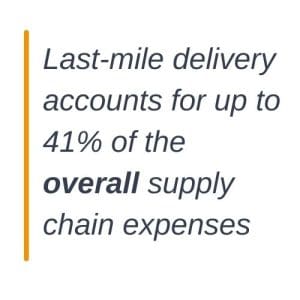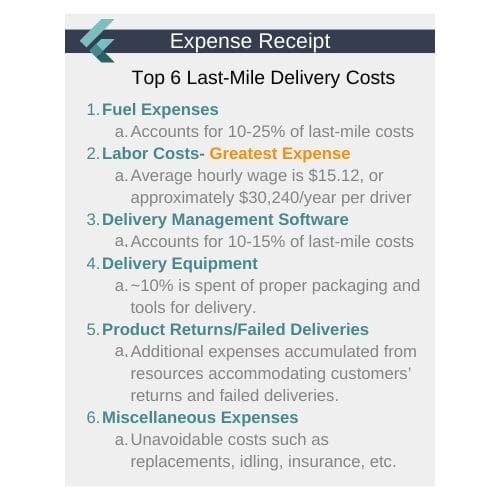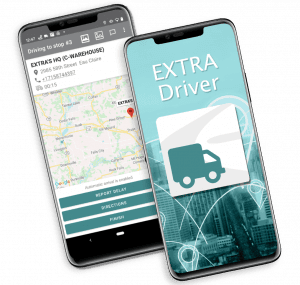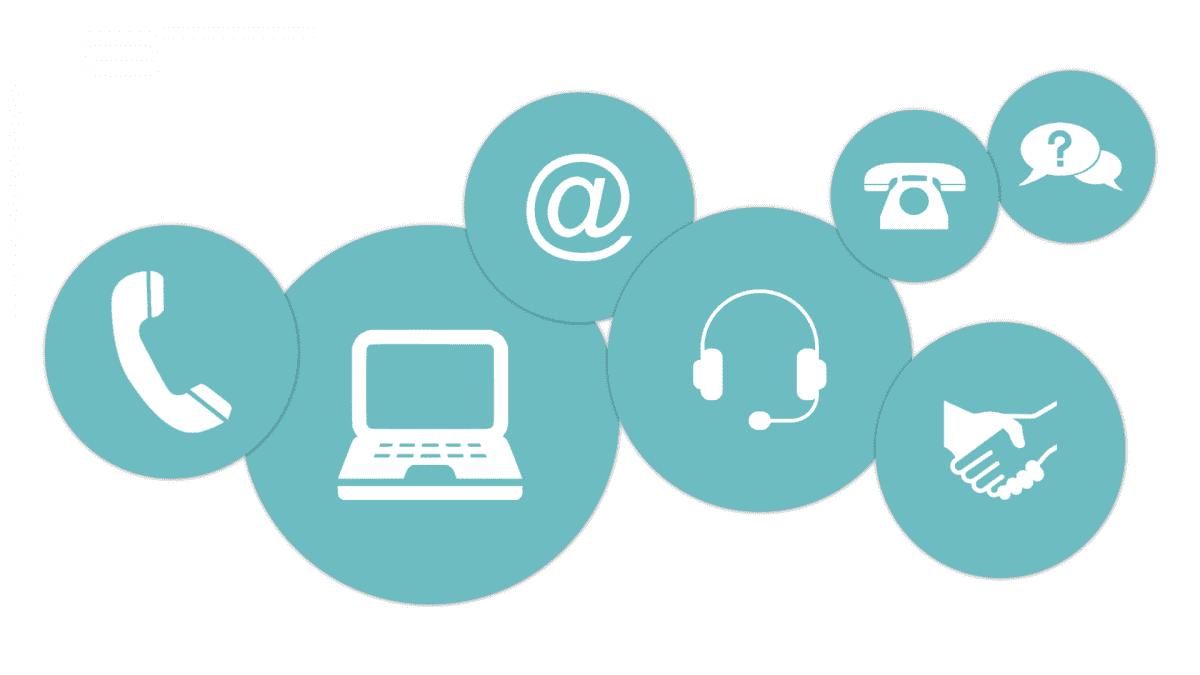
When the concept of last-mile delivery first came into the limelight, not many paid attention. Then Amazon Prime happened, and the rest, as they say, is history.

Today’s consumer wants their order right…and they want it right now at the cheapest rates possible. Consequently, this expectation puts online retailers in a very tight spot—they’re having to work doubly hard to keep last-mile delivery costs down amid high order volumes.
Thus the final leg of delivery is costly as it accounts for up to 41% of the overall supply chain expenses. Squeezing out healthy profits from such slim margins is no easy feat, but it’s doable. Read on to find out how.
The Last-Mile Problem
The last-mile delivery, also known as final-mile delivery, is the last step in a product’s journey. In essence, this is when the product is ferried from the delivery hub to the customer’s doorstep.
That sounds like a pretty straightforward journey, right? Except it’s not. If anything, it’s fraught with challenges and complexities, hence the term “the last-mile problem.”
Consider the difficulty of reaching end users, especially in busy urban streets where congestion is the order of the day. That’s not to mean drivers serving country areas are having it any easier— encountering difficult terrain is a real possibility. Add to that all the potential routing options, service times, unpredictable road conditions, differing truck capacities, and varying driver skill levels. The result is higher fuel and labor costs, more time on the road, more idleness, and an extreme level of complexity.
In these conditions, maintaining efficiency while making customers happy is nothing short of a Herculean task. That explains why last-mile delivery is, by far, the most expensive and time-consuming part of the entire shipping process.
Just How Costly is Last-Mile Delivery? A Look at the Numbers
News about last-mile delivery costs is hardly exaggerated. On average, this final stage accounts for 53% of the total shipping costs. In other words, about half of your shipping costs are spent on the final mile. That’s more than you would spend on warehousing.
Unfortunately, it gets worse. Here are additional statistics to ponder:
- Businesses usually foot 25% of last-mile expenses, but this percentage is rising as the cost of inefficient supply chains rises.
- Unless last-mile delivery is optimized, profits could potentially decline by 26% in three years.
- Most delivery drivers pocket around $16 to $24 per hour.
- The average last-mile cost for a small package in high-density delivery can be around $10; for low-density heavy packages, it is $50.
Despite these rather lofty last-mile delivery costs, most enterprises will continue to offer delivery services to customers. Research shows that about three-quarters of customers will spend more and be loyal to brands that offer a superb last-mile experience. At the same time, most companies want to capitalize on the skyrocketing eCommerce order volumes. All this points to one indisputable fact: logistics optimization is a must if these costs are to be kept in check.

Why Last-Mile Delivery Is the Most Expensive Leg in the Supply Chain
Using the last-mile delivery model means signing up for incredibly busy days that involve sending out packages to multiple customers spread out in different geographies. The variety and volume of drop-off locations make deliveries a real hassle. Not to mention the complexity that arises when hiccups like bad weather and traffic occur.
Then there’s the issue of cost, which can quickly spiral out of control due to a few factors:
Low Average Speeds
Drivers who deliver within the last mile inevitably have to use local roads, most of which are rarely clear. As a result, the delivery vans and trucks have to decelerate, stop, and accelerate every so often. This greatly impacts fuel efficiency and average speeds.
Downtime and Idling
In cities especially, drivers idle a lot in between drop-offs. The many traffic lights, vehicles, and winding streets they encounter along the way make it nearly impossible not to idle. Delivery trucks, on average, waste 0.84 gallons per hour when idling, which can drive up fuel costs significantly.
Failed Deliveries
Failed deliveries happen for various reasons. There may be an issue with the goods themselves, or they may not fit in the elevator up to the consignee’s condo, or there may have been an undisclosed set of stairs that posed a challenge. But more often than not deliveries fail for the simple reason that the customer wasn’t ready to receive the order when the driver showed up.
Whatever the case, every failed delivery means more expenses for your business. It’s highly unlikely that you are charging your customers additional delivery fees for the additional delivery attempts, which means you are shouldering the cost yourself. On average, a single failed delivery costs $17.78, and an astonishing 5% of all last-mile deliveries fail.
Customer Demands
Customers don’t just crave quick deliveries—they demand them. One study showed that consumers are so attracted to fast deliveries that 32% of them have abandoned a purchase because the estimated shipping time was too long. Because of this, more online retailers are willing to spend on shipping costs, even if that means sacrificing a sizable chunk of their profits.
Inefficient Delivery
Last-mile delivery might have a catchy name, but the actual journey is hardly ever completed in one mile. Delivery points will vary greatly in distance and drop size.
Consider rural areas, for example. Delivery drivers have to cover great distances between delivery points just to drop off one or two items. While the delivery points in cities may be situated close to each other, any gains are swiftly offset by heavy traffic jams on highways and byways.
On top of that, the unprecedented growth of eCommerce means last-mile delivery operations are becoming more inefficient by the day. The volume of orders is simply too overwhelming for drivers to keep up with.
Reverse Logistics
Product return costs can be high simply because there are so many steps involved. These include transportation, receiving, warehousing, and reconditioning costs. Companies that don’t have processes in place to handle returns end up with a confused mess of lost products and unhappy customers.
The Top 6 Last-Mile Delivery Costs

Here are the top six expenses in the last-mile delivery that business enterprises have to shoulder:
Fuel Expenses
At the very least, fuel accounts for 10% of the overall last-mile delivery costs and, at most, 25%. It may seem like a small percentage, but the expenses can quickly add up for businesses managing a large fleet of vehicles. Also, when you launch operations in a new geographic market, fuel costs will almost certainly increase because of the complexities involved.
Besides, fuel prices may fluctuate at any time, which makes it difficult to estimate the prices when planning for last-mile delivery operations.
Labor Costs
Labor is one of the biggest expenses that fleet operators have to endure, accounting for 50-60% of the total last-mile delivery costs. Delivery drivers, in particular, cost a lot to hire and maintain, but they play an indispensable role within supply chain and logistics operations.
The United States Bureau of Labor estimates that delivery truck drivers make $15.12 an hour on average. The per-hour rate ranges from $9.43 to $29.39. Express delivery teams are even more expensive, charging around $25.10 per hour.
Delivery Management Software
Without proper planning and optimization, delivery management software can get quite costly. It accounts for 10-15% of the total cost of last-mile delivery.
On the upside, delivery management software can help businesses streamline and supercharge their workflows. For instance, an effective last-mile delivery software using AI can automatically generate the most efficient routes, dispatch those routes and orders to drivers, and facilitate seamless rerouting when need be. This level of optimization is a welcome benefit for companies looking to keep major delivery-related costs at an absolute minimum.
The secret here is to ensure the software you choose will truly help you cut down on future costs. In other words, have a subscription that enables you to scale operations and improve your agility without costing you any extra penny.
Delivery Equipment
Around 10% of last-mile delivery expenses are taken up by delivery equipment. The reasoning here is simple: it’s impossible to deliver a package safely to a customer’s doorstep without the right equipment.
Take food delivery businesses, for example. To serve fresh food, they will need crates, coolers, freeze-dried ice, and more. All of these cost money, and so does packaging.
Beyond that, consider deliveries that need special arrangements, such as those involving vaccines. The product can quickly go bad if not stored in a temperature-controlled environment. Such necessities ultimately make last-mile delivery services more expensive than they should be.
Product Returns and Failed Deliveries
If your business offers free returns within a designated timeframe, then you’ll likely feel the pinch every time a delivery fails to impress a customer. You have to spend resources to ship the product back from the customer and spend more to store the rejected product in the warehouse. All the while, you are getting nothing in return.
Similarly, failed deliveries mean potentially double expenses for the company. That’s because a delivery driver has to deliver the same package twice, hurting the company’s bottom line.
Miscellaneous Expenses
During last-mile delivery, businesses must cater to a slew of unexpected but unavoidable costs. These include replacement costs, rescheduling costs, idling costs, insurance, and overtime, among other expenses. While they may seem trivial at first glance, these costs have a huge cumulative effect on a company’s bottom line in the long haul.
How Can You Minimize Last-Mile Delivery Costs?
Given the above, it’s easy to see why optimizing last-mile shipping often results in high-cost savings for retailers and eCommerce businesses.
Improving last-mile delivery operations so companies can offer on-time, speedy delivery is crucial in offering customers a great delivery experience.
It all starts with implementing a few key solutions:
Provide More Shipping Options
Same-day delivery isn’t always the preferred choice of consumers. One study showed that 73% of online shoppers prioritize convenient delivery time slots over fast delivery. The same study also showed these are the elements consumers would like to have in their delivery experience:
- Delivery flexibility
- Speed of delivery
- Delivery options
- Real-time visibility
As such, businesses should strive to offer more B2B delivery options while prioritizing convenience. Letting customers receive packages at their preferred time and date and allowing them to closely track their orders will help lessen the number of failed deliveries.
Driver Apps

Driver mobile apps that are capable of recording proof of delivery, such as who received the package and where it was dropped off, will make it easier to pinpoint inefficiencies in the delivery process. It’s even better if the app can allow drivers to collect signatures and photos for additional proof.
Switch to an Automated Dispatching System
A lot of time goes to waste when orders are assigned manually. Thankfully, there’s the auto-dispatch technology that automatically assigns orders to available trucks and dispatches them to the nearest location. This way, labor costs are greatly reduced.
Optimize Delivery Routes
The more dispersed the delivery points, the higher the cost per delivery.
Automated route planning and optimization are keys to fulfilling more deliveries in each run. This helps reduce costs by maximizing stops while taking into consideration different factors such as traffic, distance, driver capacity, weather conditions, and more—something that would be nearly impossible for a human planner to do unaided.
Facilitate Two-Way Communication
Often, the lack of communication between delivery drivers and customers is the root cause of failed or missed deliveries.
Providing a way for customers to receive updates directly from the delivery driver can minimize incomplete deliveries, as the customers can provide additional instructions or coordinate with drivers in case they can’t receive the package in person.
Collect Vital Data
Information such as successful vs. failed tasks, distance covered, idle time, among others, can help you find out what’s happening in last-mile deliveries. With this data on hand, you’ll be perfectly positioned to identify and correct problems and inefficiencies that are plaguing your delivery pipeline.
Elite EXTRA: Tame Your Last-Mile Delivery Costs with a Powerful, Do-It-All Solution
Let’s be honest, the main reason why the aforementioned last-mile delivery costs are continually wreaking havoc is that businesses are yet to embrace automation. Manual processes simply don’t cut it.
The sooner you adopt the right last-mile delivery solution, the better for you, your customers, your drivers, and your bottom line. Last-mile deliveries will always be present, given the growing consumer demand for convenience and speed in the fulfillment of their orders. So it makes perfect sense not to wait any longer to take the plunge.
Does that mean you invest in different technologies to handle all the various aspects of last-mile delivery? Certainly not. One solution can truly do it all, and you need not look any further than Elite EXTRA.
Our top-tier last-mile logistics software simplifies and streamlines your operations from start to finish, saving you time and money. With our solution, you can achieve advanced route planning, customized reporting, auto-routing and dispatching, product returns tracking, and every other imaginable perk within the last-mile delivery ecosystem! If you can envision it, we can offer it.
What are you waiting for? Give our routing software a try today and start building your bottom line back up, one less cost at a time.
Sources:
https://www.capgemini.com/wp-content/uploads/2019/01/Report-Digital-–-Last-Mile-Delivery-Challenge1.pdf
https://www.insiderintelligence.com /insights/last-mile-delivery-shipping-explained/
https://www.supplychaindive.com/news/last-mile-spotlight-retail-costs-fulfillment/443094/
https://www.researchgate.net /publication/24233162_Idle_ Emissions_from_Medium_Heavy-Duty_Diesel_and_Gasoline_Trucks
https://www.statista.com /statistics/1307561/shoppers-abandoned-purchase-long-shipping-times/
https://www.bls.gov/ooh/transportation-and-material-moving/delivery-truck-drivers-and-driver-sales-workers.htm







